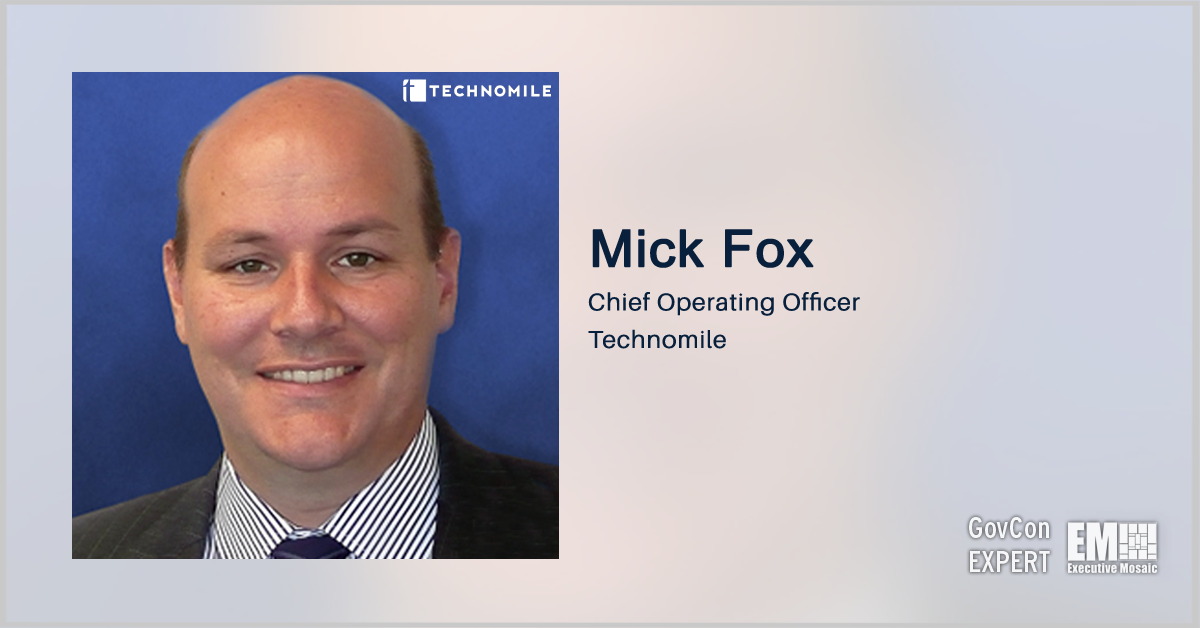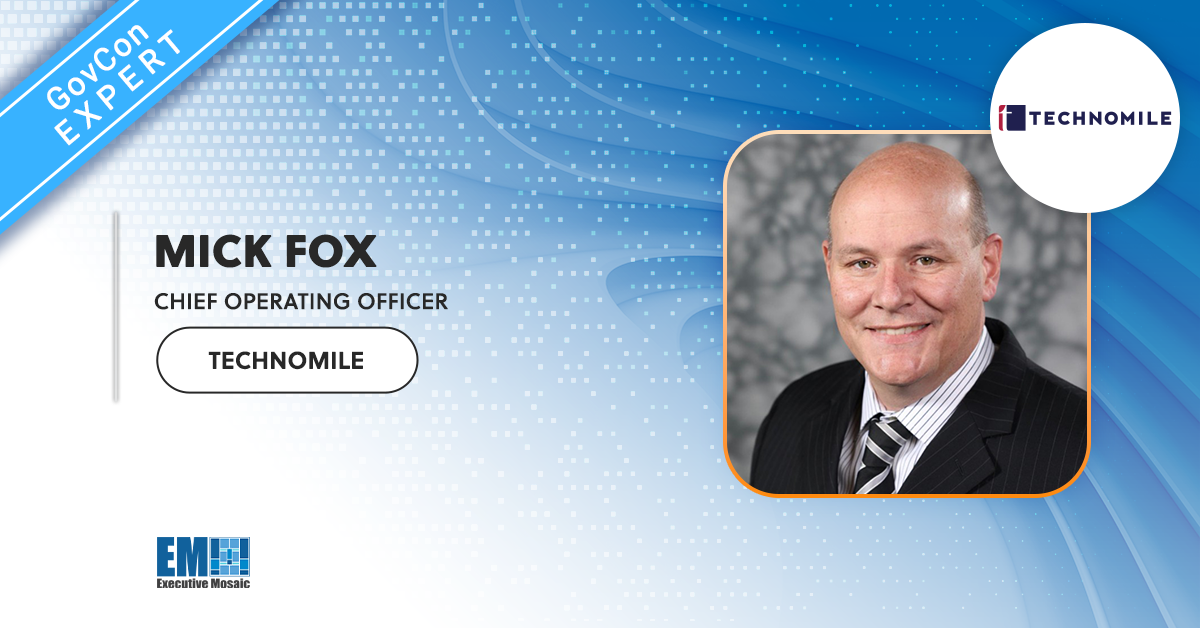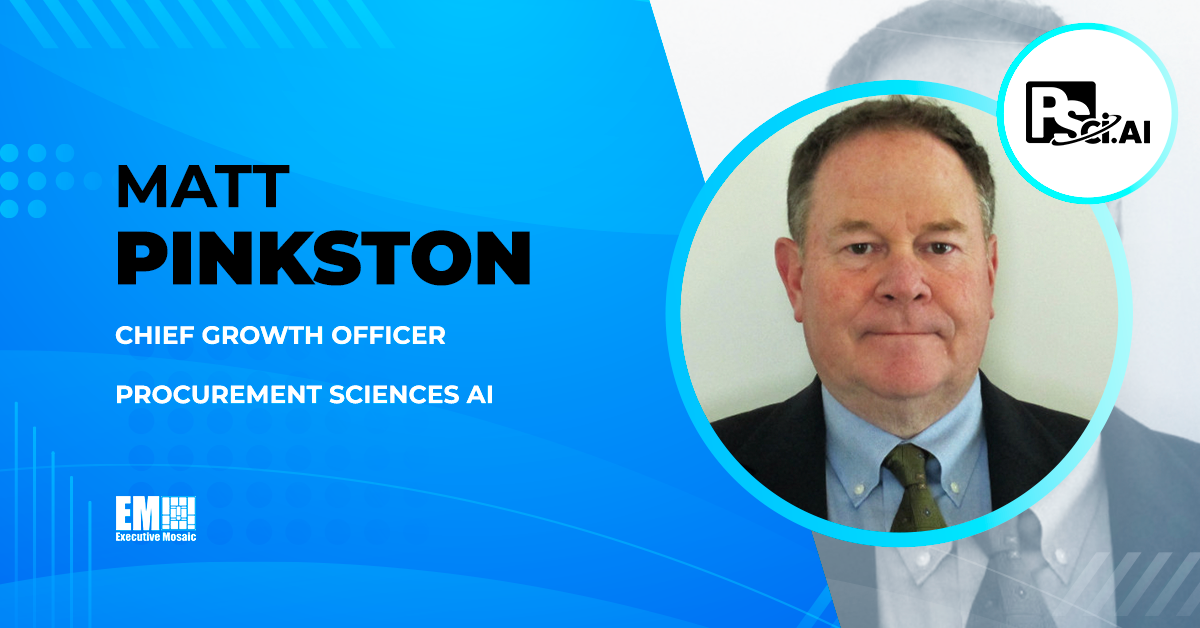Mick Fox, chief operating officer of Technomile, has provided his latest feature as a member of Executive Mosaic’s GovCon Expert program on Thursday.
In his latest piece, GovCon Expert Mick Fox provided an in-depth look into the foundational stage of maturity and the critical ways that contracting organizations are building their success with CLM technology to advance their federal contract management maturity.
You can read Mick Fox’s next GovCon Expert article below:
Building on a Bedrock of Federal Contract Management Maturity
By GovCon Expert Mick Fox
While I’ve now spent more than 25 years in government contracting and my days of service in the U.S. Air Force are well behind me, I still love to fly. If you’re an aviator like myself, you’ll be familiar with Brigadier General Chuck Yeager, a record-setting test pilot and the first commandant of the USAF Aerospace Research Pilot School.
One of his best-known quotes is, “There is no such thing as a natural-born pilot. Whatever my aptitude or talents, being a proficient pilot was hard work, really a lifetime’s learning experience.” As a pilot, I can certainly relate to the need for continuous learning and improvement of my skills.
As a business leader, I believe, as I know many of you do, that it’s incumbent upon us to push our team, department, or company to continuously improve and mature our operations…but growing, maturing and scaling hard, and even painful sometimes.
As I pivoted from the Government Contracting side of the desk to a software provider to “GovCons”, contract management is one of the most critical yet underappreciated and therefore underfunding areas of most of the companies I am privileged to work with.
It’s in this spirit that I began my article series on the Federal Contract Management Maturity Model. This tool helps contracts professionals working in the Aerospace & Defense or GovCon industries assess the current state of their contract management program – that is, the processes, technologies, and strategies being employed to manage their organization’s portfolio of government contracts – and identify the critical next steps needed to improve.
Organizations move through the model’s continuum – beginning at the Ad Hoc stage, progressing to Foundational, then Advanced, and finally to the Future-Enabling level – as they become more and more mature in their implementation and management of their federal contract management program and realize increasing business value.
The most recent article in my series focused on companies at the earliest, Ad Hoc, stage of maturity. I offered some practical guidance for “leveling up” the Contracts organization through the installation of defined, timed, and repeatable contract management processes and the implementation of CLM (contract lifecycle management) software.
Today, with the same eye on continuous improvement, let’s take a closer look at the Foundational stage of maturity and highlight some of the key ways that Contracts organizations are building upon their initial successes with CLM technology to attain an Advanced level of federal contract management maturity.
Foundational: The Bedrock is Established
At the Foundational level of maturity, you’ve got the “bedrock” established, upon which you’ll continue to advance your contract management program. At this stage of maturity, a company has made the decision to make contract management a true business partner to the company.
At this stage a company has either invested in or has budgeted for and is about to invest in a government contracting-specific CLM technology, creating a single, centralized repository to house all contracts that enables visibility across its portfolio and automates essential contract administration and compliance actions.
Systematic validations ensure critical contract details – such as clauses, CLIN/SLINs, deliverables/CDRLs, related mods and subcontracts – are consistently captured. A clause library containing FAR, DFARS, and agency-specific clauses is in place, enabling clause tracking and designation of mandatory and flow-down clauses.
Workflows are defined and documents are templated within the CLM to support key processes – e.g., OCI vetting, limitation of funds, contract briefs, CPARS responses, and contract close out – enforcing adherence to defined processes and strengthening risk and compliance management.
Global search, along with reports and dashboards, deliver real-time visibility across the organization’s portfolio of federal contracts, eliminating hidden risk, enabling efficient reporting and responses to data calls, and improving audit-readiness.
So, with this bedrock in place, where do you take your contract management program next?
Driving Towards Advanced Maturity
As a contracts leader looking to drive your department towards an Advanced level of maturity and derive increasing ROI from your investment in CLM technology, here are three recommended areas to consider:
- Leverage the power of machine learning and artificial intelligence.
One of the most labor intensive and time-consuming aspects of contract administration are all the administrative data entry aspects of contract management. From the initial set up of a contract record, to inputing the dozens if not hundreds of contract mods, to the numerous task orders, capturing all the pertinent data within the CLM is intense.
This is also one of your most crucial processes, as key drivers of CLM value, including compliance automations and reporting and analytics, all hinge upon accurate, comprehensive capture of contract details.
To ease the burden of manual data capture and the risk of human error, Contracts teams are turning to ML/AI-driven platforms that have been specifically trained to parse, extract, and ingest data from standard contract award or solicitation documents – e.g., an SF-33 form – into the CLM.
These platforms intelligently extract essential contract details – such as CLINs/SLINs/ACRNs, clauses, and contract obligations and deliverables – and present them for the Contracts team to efficiently validate. This automates contract record creation as well as obligation scheduling and management within the CLM, shaving hours off contract set-up activities and improving data integrity.
The best-in-class versions of this type of platform also support side-by-side comparison of extracted clauses against your CLM’s clause library with any discrepancies highlighted, enabling easy identification of changes in terms that could heighten your company’s business risk and may require further review by Legal.
In short, ML/AI-driven contract ingestion platforms free up Contracts teams to focus more time on managing risk and compliance, rather than administrative tasks, and equip them to proactively spot potential risk.
- Don’t leave the buy-side behind.
While your focus at the Foundational level of maturity is on centralizing data, implementing automation and improving compliance visibility and oversight to your organization’s portfolio of sell-side contracts with the government, as you continue to mature your federal contract management program, there’s opportunity to leverage your CLM technology to improve your processes around the establishment of B2B agreements required both pre and post award.
Editing Word documents and emailing them back and forth between internal and external stakeholders remains a common – and inefficient – practice for agreement management that we encounter frequently across federal contractors of all sizes.
Best-in-class government contracting-specific CLM technology also gives Contracts organizations the ability to templatize frequently-used B2B agreement types – such as NDAs, PIAs, TAs, SOWs, MSAs – and automate their generation. Defined workflows, with clear reviewer/approver/signatory roles and e-signature execution, streamline review and negotiation cycles, enforce compliance with company policy, and enable clear visibility into each agreement’s status at any point in time.
Beyond these gains, managing both sell-side and buy-side obligations within a single CLM platform offers a true 360° view of your business and the work being performed by subcontractors, plus enables more effective management of risk and compliance as you establish subcontractor agreements and seamlessly flow down mandatory clauses.
Therefore, while the majority of the lift of a corporate CLM system is to manage your relationship with the customer, considering the integration of the subcontract management processes should begin to rise in importance as you solidify your foundation of your CLM system.
- Integrate for a single source of contract truth.
Another opportunity for furthering the maturity of your contract management program is integration between your CLM and key back-office systems. Keeping contract-related data synchronized between systems is imperative to ensure compliance, timely and accurate invoicing, and quality performance, yet this is another area where many Contracts teams continue to rely on manual processes.
Partnering with your CLM vendor and your IT department to automate these data updates can yield dividends by removing administrative tasks from someone’s plate and, more importantly, by truly making your CLM system the single source of truth regarding your contracts portfolio.
The best-in-class CLM vendors will provide an enterprise integration framework to support sharing data with systems such as ERP, procurement, project management, and HRMS. They may even offer pre-built “connectors” to some of the more widely used solutions in the industry, which can help keep integration services costs down and accelerate these projects.
Your goal is a CLM that’s a “one-stop-shop” for a comprehensive view of compliance, risk, financial, and performance details for each contract, as well as insight into the people, processes, and tools that drive contract profitability.
Future-Enabling Contract Management
In my final article in this series, we’ll explore how organizations can evolve to the Future-Enabling stage of federal contract management maturity. We’ll dig into ways that forward-thinking companies are leveraging the wealth of data within their CLM, along with publicly-available procurement data, and applying ML/AI to guide strategic decision making and continuous improvement, and ultimately, deliver superior profitability and growth for their businesses.






